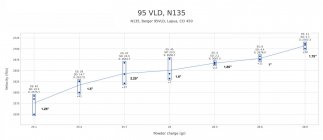Allen Corneau
Silver $$ Contributor
Quick background... I'm relatively new to loading/reloading, got started earlier this year as I added high power to my list of silhouette disciplines. Like many silhouette shooters, I'm using a 6BR and have been using the components and loads that were recommended to me by my friends that got me in this game. After initial testing I was able to get my two loads dialed in reasonably quickly and to a sufficient accuracy (about 0.5 to 0.75 MOA) and just ran with it for all the matches this year.
Now that my competition season is done until February, I started to do some more in depth ammo testing as well as checking some alternatives to bullet weight, powder, etc. I ran five different load tests yesterday on a near-perfect windless day on the 300 yard range with the range to my self. After analyzing the data, I'm struggling to understand the philosophy behind the process...
What I can't understand is how some three-shot groups can have smaller or larger extreme spread in velocities to an adjacent group and have similar or complete opposite size group on paper. For example: a group with an ES of 47 with a group size of 2.25", followed by a group with an ES of 45 and a group size of 1.6", followed by a ES of 4 with a group size of 1.85".
There are plenty of instances where a particular shot's jump/drop in velocity resulted in a high/low shot on paper, but also shots where there was a similar spread but with no flyer down range.
Another part that is making me confused about the process is some high-level high-power competitors that have YouTube channels (where I've been learning a lot) don't even look at group size during powder testing, only the chronograph data. Should I be following suit and just ignore the group sizes at this point?
Hopefully some of you fine folks can shed some light on this for me. I want to get this powder testing process figured out much better before moving on to any seating depth testing. I'm including a graph of one of my tests with the added group size indicated just to the right of each result.
Thanks.
Forum Boss: From text it appears these groups were shot at THREE HUNDRED yards (300 yds). If that's true, even 1.5" isn't bad (equivalent to 0.477 MOA).

Now that my competition season is done until February, I started to do some more in depth ammo testing as well as checking some alternatives to bullet weight, powder, etc. I ran five different load tests yesterday on a near-perfect windless day on the 300 yard range with the range to my self. After analyzing the data, I'm struggling to understand the philosophy behind the process...
What I can't understand is how some three-shot groups can have smaller or larger extreme spread in velocities to an adjacent group and have similar or complete opposite size group on paper. For example: a group with an ES of 47 with a group size of 2.25", followed by a group with an ES of 45 and a group size of 1.6", followed by a ES of 4 with a group size of 1.85".
There are plenty of instances where a particular shot's jump/drop in velocity resulted in a high/low shot on paper, but also shots where there was a similar spread but with no flyer down range.
Another part that is making me confused about the process is some high-level high-power competitors that have YouTube channels (where I've been learning a lot) don't even look at group size during powder testing, only the chronograph data. Should I be following suit and just ignore the group sizes at this point?
Hopefully some of you fine folks can shed some light on this for me. I want to get this powder testing process figured out much better before moving on to any seating depth testing. I'm including a graph of one of my tests with the added group size indicated just to the right of each result.
Thanks.
Forum Boss: From text it appears these groups were shot at THREE HUNDRED yards (300 yds). If that's true, even 1.5" isn't bad (equivalent to 0.477 MOA).

Last edited by a moderator:










